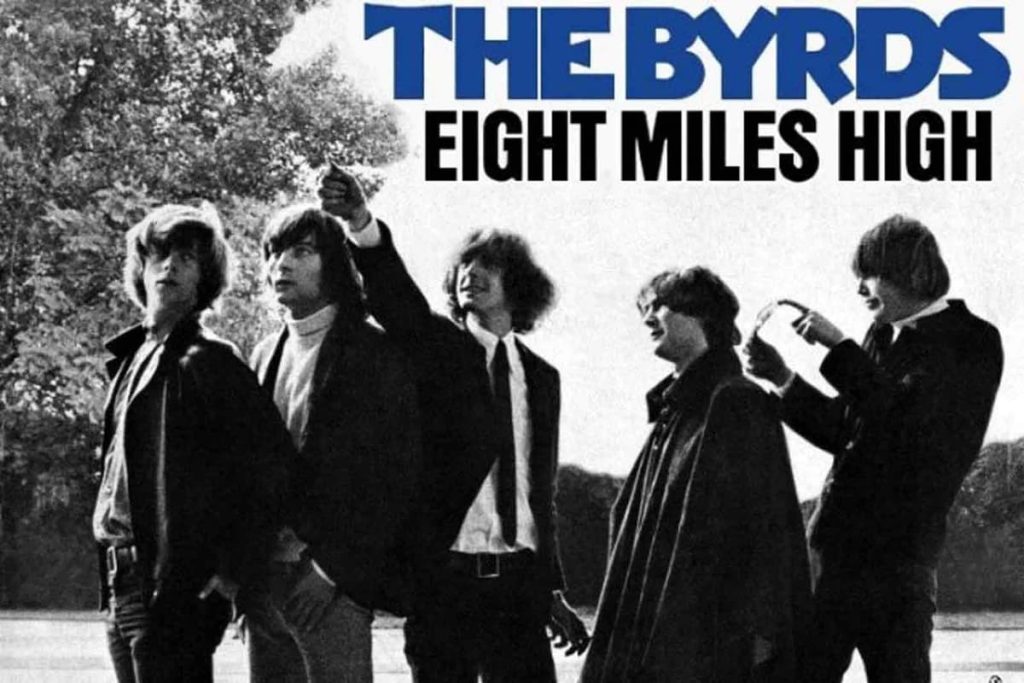
“Eight Miles High” – The Byrds’ Psychedelic Voyage into New Sonic Frontiers
Released in March 1966, “Eight Miles High” by The Byrds is often hailed as one of the earliest examples of psychedelic rock, marking a significant evolution in the band’s sound. Known for their folk roots and jangly guitar style, The Byrds had already made a name with songs like “Mr. Tambourine Man” and “Turn! Turn! Turn!” But with “Eight Miles High,” they moved into more experimental territory, blending jazz, raga, and folk-rock to create a track that would help define the emerging psychedelic movement.
The song opens with Roger McGuinn’s distinctive, droning 12-string guitar, heavily influenced by jazz saxophonist John Coltrane and the Indian sitar music of Ravi Shankar. McGuinn’s shimmering guitar riff serves as the backbone of the track, introducing a hypnotic, modal quality that contrasts with the more structured chord progressions of folk-rock. This use of dissonance and improvisational feel would later become hallmarks of the psychedelic genre, setting “Eight Miles High” apart from anything else on the airwaves at the time.
The lyrics, penned primarily by Gene Clark, with contributions from McGuinn and David Crosby, offer a surreal reflection of the band’s experiences during their first trip to England. Although the lyrics make cryptic references to air travel and the disorienting experience of international tours—“Eight miles high, and when you touch down / You’ll find that it’s stranger than known”—the song quickly gained a reputation for being a metaphor for drug use. Given the burgeoning counterculture of the 1960s, many listeners interpreted the song as a celebration of psychedelic exploration, despite the band’s claims that the lyrics were meant to capture the feeling of alienation they encountered abroad.
On a musical level, “Eight Miles High” pushed boundaries not just with its unique blend of influences, but also in how it subverted the conventions of pop songwriting. The song’s shifting harmonies and ambiguous structure broke away from the standard verse-chorus-verse format. Chris Hillman’s rolling bass lines and Michael Clarke’s jazz-inspired drumming add to the improvisational feel, giving the track a loose, flowing energy that was uncommon in mainstream music at the time.
Upon its release, “Eight Miles High” peaked at No. 14 on the Billboard Hot 100, a respectable achievement, but the song’s commercial performance was hindered by radio bans. Some stations refused to play it, citing its supposed connection to drug culture. However, the controversy only cemented its status as a cult classic and a precursor to the full-blown psychedelic explosion that would sweep through music by the end of the decade. In the years since, “Eight Miles High” has been recognized as a groundbreaking track that paved the way for later experimental rock acts, including The Grateful Dead and Pink Floyd.
The release of “Eight Miles High” also marked a turning point for The Byrds. Soon after the single’s release, Gene Clark, one of the band’s principal songwriters, left the group, leading to internal shifts that would affect their musical direction. With Clark’s departure, The Byrds began exploring country and rock fusion, but they never fully revisited the uncharted sonic territory they had mapped out in this track.
“Eight Miles High” endures not just for its innovations, but for capturing the spirit of the mid-’60s counterculture—a time when artists were searching for new forms of expression, both musically and spiritually. The song remains a quintessential piece of psychedelic rock history, celebrated for its ability to transcend genre boundaries while evoking a sense of exploration and wonder. Whether interpreted as a song about travel, alienation, or expanded consciousness, “Eight Miles High” continues to resonate with listeners as a testament to The Byrds’ creativity and daring.
In many ways, “Eight Miles High” is more than a song—it’s a sonic journey, inviting listeners to look beyond the familiar and experience the music as something more than just a collection of sounds. With its dreamlike guitar work and evocative lyrics, the track still manages to transport audiences, reminding us that music, like life, is often about the journey rather than the destination.